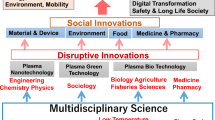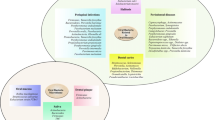Summary
Recently, plasma sterilization has attracted increasing attention in dental community for the atmospheric pressure non-equilibrium plasma jet (APNPs), which is driven by a kilohertz pulsed DC power, may be applied to the dental and oral diseases. However, it is still in doubt whether APNPs can effectively kill pathogenic bacteria in the oral cavity and produce no harmful effects on normal oral tissues, especially on normal mucosa. The aim of this study was to evaluate the bacterial-killing effect of APNPs in the biofilms containing a single breed of bacteria (Porphyromonas gingivalis, P.g.), and the pathological changes of the oral mucosa after treatment by APNPs. P.g. was incubated to form the biofilms in vitro, and the samples were divided into three groups randomly: group A (blank control); group B in which the biofilms were treated by APNPs (the setting of the equipment: 10 kHz, 1600 ns and 8 kV); group C in which the biofilms were exposed only to a gas jet without ignition of the plasma. Each group had three samples and each sample was processed for up to 5 min. The biofilms were then fluorescently stained, observed and photographed under a laser scanning confocal microscope. In the animal experiment, six male Japanese white rabbits were divided into two groups randomly (n=3 in each group) in terms of the different post-treatment time (1-day group and 5-day group). The buccal mucosa of the left side and the mucosa of the ventral surface of the tongue were treated by APNPs for 10 min in the same way as the bacterial biofilm experiment in each rabbit, and the corresponding mucosa of the other sides served as normal control. The clinical manifestations of the oral mucosa were observed and recorded every day. The rabbits were sacrificed one or five day(s) after APNPs treatment. The oral mucosa were harvested and prepared to haematoxylin and eosin-stained sections. Clinical observation and histopathological scores were used to assess mucosal changes. The results showed the obvious P.g. biofilms were formed at 10 days, and most of the bacteria in groups A and C were alive under a laser scanning confocal microscope, but the bacteria in the group B were almost all dead. In animal experiment, no ulcers, anabrosis and oral mucositis were found in both the 1-day and 5-day groups. The average mucous membrane irritation index was −0.83 and −0.67 in the 1-day and 5-day groups, respectively, suggesting that no intense mucosal membrane irritation responses occurred. It was concluded that APNPs could effectively kill P.g. in the biofilms and did not cause any pathological changes in the normal mucosa, suggesting that the plasma jet (APNPs) may be applied to oral diseases as a novel sterilization device in the future.
Similar content being viewed by others
References
Haffajee AD, Socransky S. Microbial etiological agents of destructive periodontal diseases. Periodontol, 2000, 1994,5(1):78–111
Mouton C, Hammond PG, Slots J, et al. Serum antibodies to oral Bacteroides asaccharolyticus (Bacteroides gingivalis): relationship to age and periodontal disease. Infect Immun, 1981,31(1):182–192
Tanner AC, Milgrom PM, Kent K, et al. The microbiota of young children from tooth and tongue samples. J Dent Res, 2002,81(1):53–57
Yang EY, Tanner AC, Milgrom P. Periodontal pathogen detection in gingiva/tooth and tongue flora samples from 18- to 48-month-old children and periodontal status of their mothers. Oral Microbiol Immunol, 2002,17(1): 55–59
Dzink JL, Tanner AC, Haffajee AD, et al. Gram negative species associated with active destructive periodontal lesions. J Clin Periodontol, 1985,12(8):648–659
Casarin RC, Ribeiro FV, Sallum AW, et al. Root surface defect produced by hand instruments and ultrasonic scaler with different power settings: an in vitro study. Braz Dent J, 2009,20(1):58–63
Block CM, Mayo JA, Evans GH. Effects of the Nd:YAG dental laser on plasma-sprayed and hydroxyapatite-coated titanium dental implants: surface alteration and attempted sterilization. Int J Oral Maxillofac Implants, 1992,7(4): 441–449
Sjogren U, Figdor D, Persson S, et al. Influence of infection at the time of root filling on the outcome of endodontic treatment of teeth with apical periodontitis. Int Endod J, 1997,30(5):297–306
Peters LB, Wesselink PR. Periapical healing of endodontically treated teeth in one and two visits obturated in the presence or absence of detectable microorganisms. Int Endod J, 2002,35(8):660–667
Lerouge S, Wertheimer MR, Yahia LH. Plasma sterilization: a review of parameters, mechanisms, and limitations. Plasmas Polym, 2001,6(3):175–188
Moisan M, Barbeau J, Moreau S, et al. Low-temperature sterilization using gas plasmas: a review of the experiments and an analysis of the inactivation mechanisms. Int J Pharm, 2001,226(1-2):1–21
Laroussi M. Non-thermal decontamination of biological media by atmospheric pressure plasmas: review, analysis and prospects. IEEE Trans Plasma Sci, 2002,30(4): 1409–1415
Sharma A, Pruden A, Zengqi Y, et al. Bacterial inactivation in open air by the afterglow plume emitted from a grounded hollow slot electrode. Environ Sci Technol, 2005,39(1):339–344
Sladek RE, Stoffels E. Deactivation of Escherichia coli by the plasma needle. J Phys D: Appl Phys, 2005,38(11):1716–1721
Laroussi M, Mendis DA, Rosenberg M. Plasma interactions with microbes. New J Phys, 2003,5:41.1–41.10
Zhou XC, Xiong ZL, Cao YG, et al. The antimicrobial activity of an atmospheric-pressure room-temperature plasma in a simulated root-canal model infected with Enterococcus Faecalis. IEEE Trans Plasma Sci, 2010,38(12):3370–3374
Lu XP, Jiang ZH, Xiong Q, et al. An 11 cm long atmospheric pressure cold plasma plume for applications of plasma medicine. Applied Phys Lett, 2008, 92(8):081502-1–081502-2
Lu X, Ye T, Cao YG, et al. The roles of the various plasma agents in the inactivation of bacteria. J Appl Phys, 2008,104(5):053309-1–053309-5
Kieft IE, Kurdi M, Stoffels E. Reattachment and apoptosis after plasma-needle treatment of cultured cells. IEEE Trans Plasma Sci, 2006,34(4):1331–1336
Lu X, Jiang Z, Xiong Q, et al. A single electrode room-temperature plasma jet device for biomedical applications. Appl Phys Lett, 2008, 92(15):151504-1–151504-3
Technical Standard for Disinfection. Ministry of Health of PRC. 2002:143–145
Radcliffe CE, Potouridou L, Qureshi R, et al. Antimicrobial activity of varying concentrations of sodium hypochlorite on the endodontic microorganisms actinomyces israelii, A. naeslundii, Candida albicans and Enterococcus faecalis. Int Endod J, 2004,37(7):438–477
Ferraria PH, Cai S, Bombana AC, et al. Effect of endodontic procedures on enterococci, enteric bacteria and yeasts in primary endodntic infections. Int Endod J, 2005,38(6):372–372
Zhou ZZ. Histology and Embryology (Chinese). Fifth edition. Beijing: People’s Medical Publishing House, 2001:150–219
Author information
Authors and Affiliations
Corresponding authors
Additional information
The authors contributed equally to this work.
This project was supported by a grant from the National Natural Science Foundation of China (No. 10875048).
Rights and permissions
About this article
Cite this article
Liu, D., Xiong, Z., Du, T. et al. Bacterial-killing effect of atmospheric pressure non-equilibrium plasma jet and oral mucosa response. J. Huazhong Univ. Sci. Technol. [Med. Sci.] 31, 852–856 (2011). https://doi.org/10.1007/s11596-011-0690-y
Received:
Published:
Issue Date:
DOI: https://doi.org/10.1007/s11596-011-0690-y




